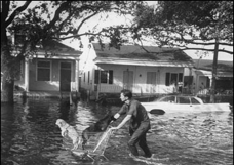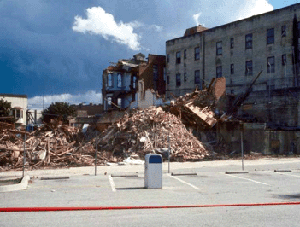Part 1: History: The Problems Are Inherent
The U.S. constitution established a federal system of “dual authority” incorporating both national and state sovereignty. The product of a series of political accommodations made at the 1787 Constitutional Convention, federalism was designed as an opportunistic political battlefield with ambiguous boundaries, one that makes it possible to displace substantive policy conflicts with perpetual quarrels over the division between state and national power. In other words, federalism has involved — and continues to involve — clashes over which level of government should control which tools of public policy and how each level should use those tools to govern. Moreover, decisions about which level of government should be in charge of which responsibilities are never politically neutral, for the balance of political forces and incentives may be very different in the national arena, a particular state, and any given locality.
 Gulfport, Mississippi (Hurricane Katrina 2005) |
People sculling down a flooded street might well have been the last image that the late North Carolina governor and U.S. Senator Terry Sanford had in mind when he coined the phrase rowboat federalism in 1967. Contrasting this notion to theories emphasizing competition between national and state governments, Sanford maintained that “the governments are all in the same boat, tossed by the same waves, and dependent on each other’s paddles. When any one fails to row, they all move more slowly, and the waves become more dangerous for all.” Today, however, in the post-Katrina era, there exists only tragic irony in his choice of words.
As was the case with many policy areas, disaster relief in the United States was considered a state and/or local matter — if not a private voluntary charitable one — for much of the country’s history. Thus, prior to the mid-twentieth century, congressional legislation offered only ad hoc relief in specific instances (128 of them between 1803 and 1950 for various droughts, earthquakes, fires, floods, hurricanes, and tornadoes). Such assistance was almost exclusively in kind, most often in the form of medical personnel, supplies, and transportation, rarely as direct payments to either governments or individuals. President Grover Cleveland’s explanation of an 1887 veto of emergency funds for drought victims in Texas expressed the dominant attitude: “I can find no warrant for such an appropriation in the Constitution and I do not believe that the power and duty of the General Government ought to be extended to the relief of individual suffering which is in no manner properly related to the public service or benefit. . . . Federal aid encourages the expectation of paternal care on the Government and weakens the sturdiness of our national character.”
Nevertheless, Congress began institutionalizing disaster relief in 1905, establishing a “public-private” partnership with the Red Cross and authorizing the organization to act as the federal government’s “official agency” for collection and distribution of emergency resources. Not until the 1950 Disaster Relief Act, however, did Congress create a permanent federal emergency fund, with monies initially limited to repair or replacement of government facilities and public infrastructure. Following Hurricane Camille’s devastation of the Gulf Coast in 1969 (estimated damage: $8 billion), policy was extended to cover losses sustained by individual citizens and the private sector. By the mid-1970s, the national government had assumed a substantial share of disaster relief, its portion of the total outlay having increased from 1% a quarter century earlier to over 70%.
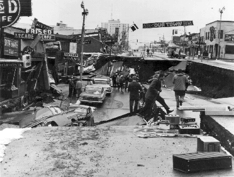 Anchorage, Alaska (Earthquake 1964)
|
From its beginnings, the federal “natural disaster” program was secondary to “civil defense” concerns — 1950 also witnessed passage of civil defense legislation — as preparing for nuclear war trumped preventing and mitigating the impact of domestic hazards and catastrophes. Assigned low priority and allocated little money (the initial appropriation was a miniscule $5 million), relief was placed in the hands of several Cold War agencies. Moreover, the Strangeloveans charged with “emergency management” favored “long term recovery” to immediate assistance. Patchwork and piecemeal changes followed calamities such as the 1964 Great Alaskan earthquake (aka the Good Friday earthquake; estimated damage: $2 billion), 1965’s Hurricane Betsy (estimated damage: $6 billion), and the aforementioned Camille. Unsurprisingly, confusion, disorganization, and ineptitude reigned — a circumstance that Congress did little to alleviate in 1974 when it created a federal disaster administration under the auspices of the Department of Housing and Urban Development (HUD). By the time President Jimmy Carter — reacting to widespread criticism of the federal government’s ineffective response to the Three Mile Island nuclear accident in 1979 — issued an executive order establishing the Federal Emergency Management Administration (FEMA), more than 100 government agencies had some sort of disaster relief responsibility.
Carter’s attempted consolidation and centralization of federal relief duties, which resulted in a relatively small agency with a modest budget, did not produce much in the way of improved performance. Ronald Reagan’s first FEMA director, Louis Giuffrida, was a former state commander of the California National Guard whom Reagan had assigned the task of “counter-terrorism” training when governor of that state in the early 1970s. Giuffrida, who pushed the agency towards a controversial “nuclear blast” shelter and urban evacuation plan, had previously developed contingency proposals to detain anti-Vietnam War protesters and written of the need to intern and relocate African-Americans in the event of “race riots.” Reagan’s White House, committed to “devolving” federal obligations in many policy areas to state and local governments — when not intent on their disappearance — used FEMA as a “dumping ground” for political patronage. George H.W. Bush maintained federal disaster relief’s historic Cold War mission and continued the practice of “spoils,” presiding over an agency that spent 50% of its budget on “civil defense” and housed ten times the number of political appointees of most other government agencies.
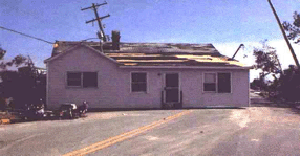 Sullivan’s Island, South Carolina (Hurricane Hugo 1989)
|
Two 1989 events typified FEMA’s clumsiness, not to mention its callousness. First, Hurricane Hugo blew through the Caribbean and the Carolinas (estimated damage: $16 billion). Assistance was delayed in Puerto Rico when the territorial governor’s request for aid was returned because a portion of the form was incomplete. Then, having neglected — since its inception — to establish “standard operating procedures” for coordinating relief activities, the agency failed to respond to the needs of poor rural South Carolinians who went days without food and water and waited more than a week for FEMA to open an emergency operations center. Shortly thereafter, the Loma Prieta earthquake — named for the highest peak in the Santa Cruz Mountains — shook northern California (estimated damage: $12.5 billion). Here, the most vulnerable were met by the intransigence of those ostensibly responsible for helping them. Poorly paid Latino and Latina migrant workers in Salinas and Watsonville found themselves “locked out” of FEMA temporary housing if they were unable to provide documentation that they had resided at the same address for more than one month.
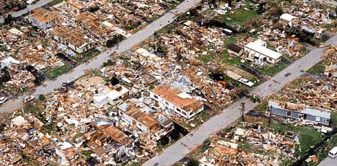 Homestead, Florida (Hurricane Andrew 1992) |
Stung by the angry reaction to its poor performance in the post-Hugo and Loma Prieta situations, FEMA unveiled a “comprehensive response plan” in early 1992, only months, it turned out, in advance of Hurricane Andrew wiping out portions of South Florida (estimated damage: $30 billion) and the less-remembered Hurricane Iniki wreaking havoc in Hawaii (estimated damage: $4 billion). Any “preparedness” that agency officials may have thought their plan provided was undone by the magnitude of these twin storms. Additionally, the contradictions of federalism were visible in Florida as Bush 41 insisted that Governor Lawton Chiles had “dropped by ball” in not formally requesting federal help, while Chiles asserted that bureaucratic “red tape” seemed unnecessary given the televised images of destroyed buildings and devastated lives (more than 100,000 residences were either severely damaged or reduced to rubble). Disaster relief in Miami and Dade County would eventually become the largest — until Katrina — domestic peacetime military operation in U.S. history, with more than 20,000 troops deployed to the area.
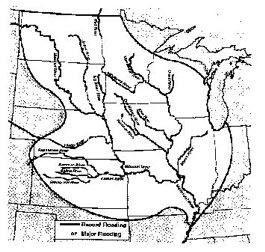 Figure 1. Area Impacted by the 1993 Midwest Flood |
In 1993, amidst calls to abolish FEMA following the Andrew debacle, new president Bill Clinton appointed the first director in the agency’s history with actual disaster relief experience. Under James Lee Witt, FEMA showed marked improvement in dealing with the Midwestern floods of that year (estimated damage: $20 billion) and California’s Northridge earthquake in 1994 (estimated damage: $20 billion). In contrast, however, to focusing on responding to disasters after they occur, Witt favored “natural hazard mitigation” which seeks to reduce the vulnerability of communities to potential calamities and reduce repetitive losses. Mitigation approaches run a long gamut from public awareness and education and to land-use planning and regulation. Of course, public policy in many — in fact, most — of these areas remains the domain of state and local governments. No matter, “constitutional” limits to federal mandates were consistent with the Clinton Administration’s desire to abide by David Osborne and Ted Gabler’s “reinventing government” dictum: “government should steer, not row.” In other words, Washington ought to set policy, but it should not provide services. Pursuant to this, FEMA implemented Project Impact and set out, in rowboat federalist fashion, to encourage states, localities, and businesses to become more “disaster resistant” through program grants, matching funds, and public-private partnerships.
Bush 43’s presidency zero-budgeted Project Impact upon entering the White House in 2001 and the effort was allowed to expire (appropriations were actually quite small, never exceeding $25 million a year during its brief existence). Had that not happened, the project would likely have “run aground” anyway because of the political unwillingness to address land-use issues, whether for fear of alienating the so-called “property rights” movement or running afoul of the judiciary on 5th Amendment “takings” issues. In any event, FEMA was absorbed into Homeland Security after 9/11, Congress and the president, in effect, reviving “civil defense,” this time against “terrorist attacks.” Bush also renewed use of the agency as a place to house “political hack” appointments. Emergency managers throughout the country claim that the current administration has weakened FEMA, therefore, it contributed to the disorganized and ineffectual response to Hurricane Katrina. No doubt true, but the agency’s 2004 pre-and-post-storm Florida activities (class and racial biases notwithstanding) positioned disaster response equipment, personnel, and supplies across the state in sharp contrast to what happened along the Gulf Coast and New Orleans in 2005. Might the difference have been a governor in the former circumstance who happened to be the president’s brother? Or was it “battleground” electoral politics in the “sunshine”‘ state? Conversely, could the disparity really have been the presence of a “blue” city in a “red” region in the latter instance?
U.S. federalism has produced intergovernmental “disaster management” that relies upon both informed state and local government risk assessment, disaster mitigation, and crisis preparation and federal administrative support, technical assistance, and resource mobilization. Therefore, the inability of one level of government to transition from routine public service to emergency relief inhibits the capacity of other levels of government to function in supportive roles. System failure often results from breakdown in the process of interdependent communication and action, particularly when and where geographic and demographic redistribution of resources is most needed. While such catastrophes are no longer understood to be “untreatable acts of god” that can only be lamented, they are yet to be fully recognized as events caused and exacerbated by the convergence of natural hazards, economic relations, and social structures.
Further Reading
Barnett, Barry. 1999. “US Government Natural Disaster Assistance: Historical Analysis and Proposal for the Future.” Disasters 23.2: 139-155.
FEMA History. 2004. http://www.fema.gov/about/history.shtm.
Platt, Rutherford. 1999. Democracy and Disaster: The Politics of Extreme Natural Events: Island Press.
Pocock, Emil (ed.). Disasters in the United States, 1650-2005. http://www.easternct.edu/depts/amerst/disasters.htm
Steinberg, Ted. 2000. Acts of God: The Unnatural History of Natural Disaster in America: Oxford University Press.
Wisner, Ben, et al. 2004. At Risk: Natural Hazards, People’s Vulnerability, and Disasters, 2nd ed: Routledge.
 Michael Hoover is a professor of political science at Seminole Community College. Hoover co-authored City on Fire: Hong Kong Cinema. with Lisa Odham Stokes. Hoover serves on the editorial board of New Political Science, journal of the caucus for a new political science.
Michael Hoover is a professor of political science at Seminole Community College. Hoover co-authored City on Fire: Hong Kong Cinema. with Lisa Odham Stokes. Hoover serves on the editorial board of New Political Science, journal of the caucus for a new political science.

